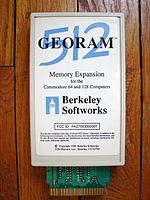geoRAM

geoRAM is a discontinued memory expansion unit designed to work with the Commodore 64 and the 128 computers. GeoRAM was specifically designed to work with the GEOS operating system. geoRAM was created by Dave Durran.[1][2]
During the chip shortages of the 1980s, Commodore could not produce enough of its RAM Expansion Units (they eventually cancelled them). The GEOS operating system relied heavily on extra RAM and so the company behind GEOS produced their own memory expansion cartridge, called the geoRAM.[3][4]
By using a mapped-in page scheme, RAM contents on the cartridge are directly accessible by the CPU, and don't rely on DMA like the REU cartridges, which enable memory transfers between system RAM and REU much faster than the system CPU can do. Hence, there's no other benefit than extra RAM, and not much software other than GEOS actually supported it.
References
- ^ The GEOS Column: Closeup on GEORAM, By Robert Bixby, Page 14, Issue 83, 1990 May, Compute Gazette
- ^ Dave Durran, Vice President, Hardware Development, Mr. Durran was a cofounder of Geoworks and served as Hardware Architect there from 1983 to 1998.
- ^ First look at: geoRAM
- ^ 13.3.2. What is a geoRAM Unit?, When Commodore REUs became hard to find several years back, Berkeley Softworks introduced geoRAM, which is a 512K RAM expander. This RAM expander gives you all of the advantages of a 1750 with GEOS. However, it is not 1750 compatible, so it will not work like a 1750 outside of GEOS; it is transparent to other programs. (As a caveat on this, see the info on RAMLink)). DesTerm128 2.0 will not work with a geoRAM plugged in. A special version of GEOS 2.0 (which is bundled with geoRAM) is necessary to use geoRAM. No additional power supply is necessary to use geoRAM., COMP.SYS.CBM: General FAQ, v3.1 Part 8/9
